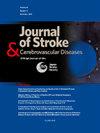Dystypia following left lenticulostriate artery cerebral infarction: A case report with MR Tractography and SPECT analysis
IF 1.8
4区 医学
Q3 NEUROSCIENCES
Journal of Stroke & Cerebrovascular Diseases
Pub Date : 2025-07-05
DOI:10.1016/j.jstrokecerebrovasdis.2025.108389
引用次数: 0
Abstract
Objectives
To report a rare case of dystypia—a selective typing impairment—following a subcortical infarction, and to explore its neural correlates using clinical and imaging data.
Case Presentation
A 65-year-old right-handed man with proficient typing ability developed sudden difficulty typing during a web conference. He showed intact language comprehension, naming, and motor function, but exhibited romanization errors and touch-typing difficulties without agraphia, apraxia, or aphasia, while the Frontal Assessment Battery revealed impaired verbal fluency.
Imaging Findings
MRI revealed an acute infarct in the left putamen and corona radiata. Diffusion-weighted imaging with tractography showed partial involvement of the fronto-striatal tract connecting the putamen to the supplementary motor area. SPECT demonstrated hypoperfusion in the left frontal and parietal cortices.
Conclusion
This case suggests that disruption of the fronto-striatal tract may impair typing ability, even in the absence of classical language deficits. Subcortical lesions can cause highly selective cognitive-motor dysfunctions, and combined clinical and imaging approaches are key to understanding such atypical post-stroke presentations.
左透镜状纹状动脉脑梗死后发育不良1例:磁共振束状图和SPECT分析。
目的:报告一例罕见的皮层下梗死后的类型障碍(一种选择性分型损伤),并通过临床和影像学资料探讨其神经相关性。案例介绍:一名65岁的右撇子男子,打字能力熟练,在一次网络会议中突然出现打字困难。他表现出完整的语言理解、命名和运动功能,但表现出罗马字母错误和触摸打字困难,但没有失写症、失用症或失语症,而额叶评估显示语言流畅性受损。影像学表现:MRI显示左壳核和辐射冠急性梗死。带束造影的弥散加权成像显示连接壳核和辅助运动区的额纹状体束部分受累。SPECT显示左侧额叶和顶叶皮层灌注不足。结论:本病例提示,即使没有经典语言缺陷,额纹状体束的破坏也可能损害分型能力。皮质下病变可引起高度选择性的认知运动功能障碍,结合临床和影像学方法是理解这种非典型卒中后表现的关键。
本文章由计算机程序翻译,如有差异,请以英文原文为准。
求助全文
约1分钟内获得全文
求助全文
来源期刊

Journal of Stroke & Cerebrovascular Diseases
Medicine-Surgery
CiteScore
5.00
自引率
4.00%
发文量
583
审稿时长
62 days
期刊介绍:
The Journal of Stroke & Cerebrovascular Diseases publishes original papers on basic and clinical science related to the fields of stroke and cerebrovascular diseases. The Journal also features review articles, controversies, methods and technical notes, selected case reports and other original articles of special nature. Its editorial mission is to focus on prevention and repair of cerebrovascular disease. Clinical papers emphasize medical and surgical aspects of stroke, clinical trials and design, epidemiology, stroke care delivery systems and outcomes, imaging sciences and rehabilitation of stroke. The Journal will be of special interest to specialists involved in caring for patients with cerebrovascular disease, including neurologists, neurosurgeons and cardiologists.
 求助内容:
求助内容: 应助结果提醒方式:
应助结果提醒方式:


